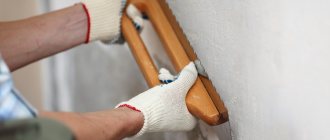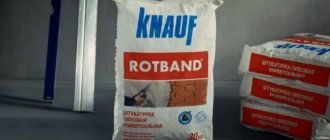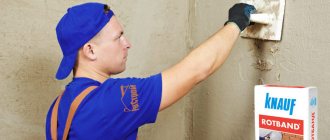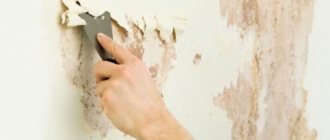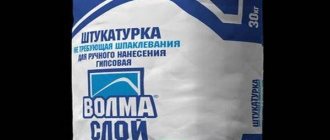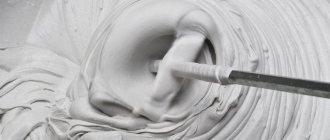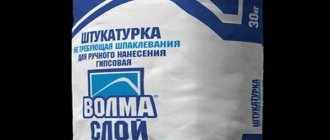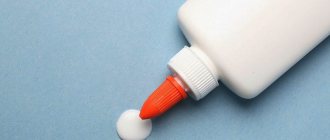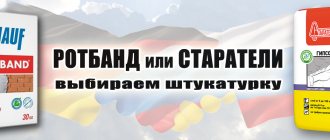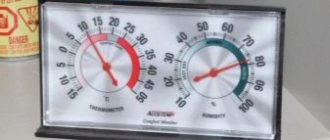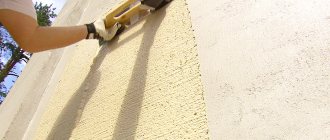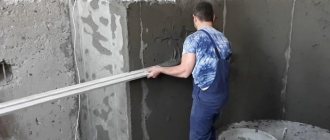To level the surface of walls and streams inside the house, it is recommended to use ready-made dry mixtures. The most popular option is universal gypsum plaster - rotband.
This is a plaster mixture produced by the Knauf company. More detailed instructions for use and consumption of gypsum plaster Knauf Rotband 30 kg are discussed below.
Rotband "Knauf" gypsum plaster: application
Plastering and finishing walls can be done in several ways, one of which involves the use of a German universal mixture based on the Knauf Rotband gypsum binder. Rotband plaster material has been sold and used on our market for decades, and during this time it has earned a huge number of positive reviews and interesting questions.
What is gypsum plaster mass from
German specialists, traditionally producing high-quality dry plaster, still keep the main components and method of producing the gypsum mass a secret. By law, they are only required to confirm the sanitary safety and environmental friendliness of gypsum plaster, but have the right not to disclose production technology, which they regularly do. As long as gypsum rotband is used, questions arise about its composition.
It is only known that the dry plaster composition of rotband includes:
- Gypsum mass with additives that improve water adhesion and prevent shrinkage:
- Plasticizers that increase the fluidity and hardness of the gypsum surface after setting;
- Dust-like inert filler based on silicon oxide with a fine-crystalline structure.
To prepare the finished Knauf Rotband gypsum mixture with your own hands, you just need to add clean water, exactly as much as the instructions require, and mix the mixture with a mixing attachment. Per kilogram of dry gypsum rotband powder consumes 0.6 liters of water. After activation and mixing with a mixer, the rotband gypsum mass remains in working condition for another 40 minutes, the plaster dries quite quickly. During this time, it is necessary to complete most of the finishing operations. How long exactly the Knauf rotband material will set depends on the temperature, air humidity and the presence of a draft.
The advantages of the universal plaster mass “Knauf” rotband over cement plasters can be formulated in four points:
- High quality surface, absence of deformation and cracking of the gypsum mass, subject to the rules for preparing the solution specified in the instructions;
- Almost halved consumption of gypsum plaster compared to sand-cement compositions;
- The versatility of Knauf rotbands allows you to use the same mass both as plaster and putty.
- Environmental friendliness and safety. The use of gypsum binders, according to the developers, makes the room more comfortable for human occupancy. In addition, gypsum material has better thermal insulation, dries faster and is resistant to open flame.
They produce dry gypsum mixture Rotband "Knauf" in soft packaging weighing 30 kg. The name gypsum universal plaster is often confusing when, upon opening the bag, a person sees in front of him a gray mass resembling cement. In fact, the dry mixture of Knauf rotbands has long been produced not only in Germany, but also in a number of CIS countries, including the Russian Federation. Therefore, the dry mass can be gray, white or pink. As the plaster dries on the surface of the walls, it gradually becomes lighter and becomes almost white.
There are a lot of fake Knauf rotband plasters sold on the market, so you can easily get into trouble, not knowing how to distinguish a fake from the original.
Ready-made mixtures can be stored in packaged form for up to six months; dry plaster cannot be stored in an open container for more than a week. Instructions and storage rules are always given on the packaging of gypsum plaster.
Practical use of rotband gypsum mixture
Using ready-made plaster mixture, you can finish almost any building material used for arranging the walls of residential and auxiliary premises. You can plaster brick, concrete, foam block and even polystyrene foam without reducing the strength or quality of the surface. But in each specific case, it will be necessary to take additional measures to improve adhesion to the base of the wall.
The use of gypsum plaster for wall decoration involves the use of other products in combination with rotband. Before applying plaster to brick, foam concrete, or any porous structure, use Knauf Grundiermittel primer; for concrete walls and polystyrene, use Knauf Betokontakt deep penetration composition.
Preparing the walls and applying the base layer of gypsum plaster
Initially, the wall is cleaned of dust and remnants of masonry mortar. To do this, you can use a construction hammer and a dry brush. After cleaning, the stone or concrete surface is primed in accordance with the instructions. After treatment, the surface of the walls dries for at least a day.
At the next stage, the installation of galvanized steel beacons is carried out, along which the surface of the plaster will be leveled.
The distance between the beacon strips should not exceed ¾ of the length of the rule. Beacons are attached to a primed wall using a small amount of plaster mixture and leveled using a building level and a stretched line or laser level gauge. In addition, a fishing line or laser will allow you to calculate how much ready-made rotband gypsum mass will be needed for arranging the plaster.
After the wall is prepared, you will need to prepare a gypsum plaster mixture.
To prepare the Knauf rotband gypsum mass, you will need a 30-35 liter plastic container, 18 liters of water and one package of dry universal plaster. Typically, the composition for plastering a wall is prepared as follows:
- 30% water and a small amount of dry mixture, 4-5 kg, are added to the container, mixed with a trowel;
- Next, the rest of the water is added to the tub and all the gypsum mass remaining in the bag is poured out;
- Beat the mixture for five minutes using a mixer attachment until creamy;
- The finished plaster mixture sits for another five minutes, and you can begin finishing the walls.
The finished gypsum mass has the consistency of semi-liquid sour cream; it is scooped onto a spatula in portions of 400-500 grams and forcefully thrown onto the wall in rows from bottom to top.
In order to calculate how much mixture is required for plastering a wall, use the following ratio: for plaster 10 mm thick, prepared from a 30-kilogram bag, the plaster mass is enough for 3.1-3.3 m2. The manufacturer recommends applying gypsum plaster with a thickness of 5 to 25 mm. In practice, the rotband held up perfectly on the walls even with a layer thickness of 1 to 40 mm.
Immediately after finishing throwing the plaster mixture onto the wall, using an H-shaped rule, the mixture is pulled up and at the same time leveled along the installed beacons. The planks should not protrude onto the surface of the plaster, otherwise the wall will become ribbed after drying.
The quality will be slightly lower, but you can finish almost any surface with rotband. In this case, corner mesh profiles made of plastic or aluminum installed at the corners of the walls are used as beacons. Laying technology without the use of beacons is a little more complicated and requires good visual memory.
Initially, a rough layer of Knauf plaster is laid on the wall, after which the rule is to measure and look for depressions on the treated surface. With the second layer, the defects are rubbed with a rotband, and the excess is removed using the rule. On the third layer, the plaster is smoothed with your own hands in the usual manner.
Leveling and filling the applied plaster
Approximately 15 minutes after the first treatment with the rule, the rotband plaster dries, stops floating down, and it can be leveled with a fine trapezoidal rule or a wide trowel.
After the surface has become smooth, but slightly rough, they proceed to smoothing the Knauf Rotband plaster with a dense sponge material glued to the sole of the trowel. After this treatment, the surface becomes soft and is additionally polished with a wide spatula. The polished layer dries for 20-24 hours at room temperature. For extreme cases, at a minimum temperature of 5 o C, the rotband material dries for several days. On such a wall you can glue wallpaper yourself or apply decorative plaster.
Universal plasters Rotband
Rotband gypsum plaster is a development by specialists from Knauf Germany, a manufacturer of building mixtures. This universal mixture is produced by Russian manufacturers under license. The quality of the domestic rotband product matches the quality of German manufacturers, which is why it is often called rotband knauf. It consists of gypsum binder powder with light aggregate and polymer additives that increase adhesion.
Scope of application of Knauf gypsum plaster: during construction work and during internal repairs in buildings. It is suitable for use on bathroom walls and for finishing walls with smooth surfaces and ceilings in residential premises. The wall material can be anything.
Content
- Manufacturer, composition and technical characteristics
- Technical characteristics of gypsum plaster Rotband
- Areas of application of the mixture
- Advantages and disadvantages
- What may be needed for plastering walls, ceilings or slopes
- Rotband plaster: Instructions for use
- Storage periods and methods
- Video: Leveling walls with your own hands
- Price of Knauf Rotbahn plaster
- Analogues: what can be used instead of Rotband
- Conclusion
Technical characteristics of Knauf gypsum plaster
Knauf plaster is used for finishing surfaces of any material, and it is also applied to insulation made of polystyrene foam or mineral wool, as a finishing agent for wallpaper. The layer thickness should be in the range of 5-50 mm. The mixture is characterized by:
- high adhesive properties - 0.5 MPa;
- used only for interior decoration;
- consumption of dry finishing per 1 m2 - 8.5 kg;
- grinding - up to 1.2 mm;
- drying of the solution on the surface - a week;
- the prepared solution must be used within 20-25 minutes;
- shelf life of dry knauf plaster in a whole package is 6 months;
- the approximate drying time for a layer of mortar 10 mm thick is 45-60 minutes;
- colors: white, pink, gray;
- temperature regime for working with material +5-30°C;
- thermal conductivity coefficient - 0.25 W/m-K;
- the mixture is packed in paper bags, packaged in 30 kg, 25 kg, 10 kg, 5 kg.
Paper packaging 5 kg
To finish the walls outside, Knauf cement plaster is used.
Video description
The video will tell you about the difference between Rotband and other gypsum plasters: Experienced craftsmen believe that for the final hardening of the applied layer of plaster and for it to reach the standard humidity, it takes the same number of days as its thickness is in millimeters. After this, you can putty, paint the surface and finish it in another way.
It's another matter if the alignment is performed in several layers. In this case, it is better not to allow the previous layer to dry out, but to apply the next one on a damp surface.
For reference! The maximum thickness of one layer of plaster should not exceed 30 mm.
The mixture is available in 10 and 30 kg packages in three-layer paper bags that protect the contents from moisture. In them, it retains its properties for up to six months. Violation of the integrity of the packaging significantly reduces this period, so it is necessary to monitor this when purchasing, transporting and storing the material.
There is also another packaging available in stores - 5 kg in plastic bags Source a-komplekt96.ru/
Main series of dry finishing KNAUF
The German supplier of building mixtures Knauf produces gypsum compositions for interior use and cement compositions for exterior use in several series.
Knauf gypsum plaster is produced in the following series:
- universal gypsum plaster KNAUF Rotband;
- Golband KNAUF;
- Knauf MP 75 series;
- HP Start KNAUF.
Knauf gypsum plaster is applied manually and mechanically to finish walls and ceilings with dry and normal humidity conditions, which allows you to mechanize the process, reduce solution consumption and work time.
Knauf Goldband
Dry cement mixture is represented by the following series:
- thermal insulation composition of grünband;
- façade Knauf Unterputz;
- decorative plaster Knauf Diamond.
Golband mixture is used for plastering interior walls manually. Goldband repeats the advantages of rotband plaster; their technical characteristics are similar. The mixture consumption per 1 m2 is 8.5 kg, when applying the solution in a layer of 10 mm. The full drying cycle is a week, packaging, like Knauf Rotband 30kg.
MP 75 plaster is a highly adhesive dry composition, applied to internal surfaces using PFT series machines. The mechanized method speeds up the work process when working with Knauf MP 75 by approximately 4 times. The consumption of the mixture is slightly higher than with the manual application method, and is 10 kg/m². MP 75 product is packaged in paper bags, like Knauf Rotband 30 kg. On each package there are printed instructions for mixing the composition and the approximate consumption of Rotband plaster is given.
KNAUF starting mixture is used indoors with standard humidity levels and in rooms with a more humid microclimate: kitchen and bathroom. Correct use of Knauf Start is provided by instructions printed on each package. Packaging HP Start - 25 kg, in craft bags.
KNAUF Diamant
It is easy and quick to work with Rotband gypsum plaster, the technical characteristics of which are similar in all series. To control the correct mixing of the solution and the order of work, Knauf has developed and provides instructions. It is placed on packages with the mixture.
The main advantages of KNAUF gypsum compositions
Rotband has the following advantages:
- environmentally friendly, the composition is developed on the basis of natural material - gypsum stone;
- quick drying;
- high fire and fire resistance;
- the quality of plastered surfaces meets international standards;
- plasticity and the possibility of using mechanization in the process of surface finishing;
- Possibility of use in contact with materials for heat and sound insulation. Gives good results when used in panel houses.
Cement Knauf grünbands have thermal insulation and water-repellent characteristics and can be used both outside and inside buildings.
They include cement, fractionated sand, expanded polystyrene as filler and hydrophobic additives. This product has excellent vapor permeability and protects walls well from the aggressive influence of external atmospheric factors. It has a long service life, as it is practically not susceptible to static stress.
Knauf Grünband
Knauf Grünband is applied to stone and brickwork and heat-insulating surfaces under Knauf Diamond 260 decorative plaster, paint or ceramic tiles. The consumption of dry Grunband per 1 m2 of wall is 18.3 kg, with a layer thickness of 15 mm. Can be applied by hand or by machine.
Knauf decorative plaster is a lime-cement composition with polymer additives that enhance water-repellent properties. The material is used for interior and exterior work. Apply manually or mechanized.
Shelf life: 12 months, solution application temperature +5-25 °C.
Meet us in a new format!
New packaging design for KNAUF-Rotband
Quality standard Finishing mixtures Rotband.
Rotband is a brand of building materials loved by both finishing professionals and private craftsmen around the world. For many years, Rotband has been considered synonymous with true German quality.
The assortment of the line is represented by KNAUF-Rotband universal gypsum plaster, thin-layer putties for finishing surface preparation for decorative finishing KNAUF-Rotband Finish and KNAUF-Rotband Pasta Profi. The use of these products allows you to solve a wide range of tasks for finishing premises, such as sealing cracks, leveling walls and ceilings, and decorating surfaces.
All products of the Rotband family were developed by German specialists, are fully compatible with each other and adapted for Russian conditions. The mixtures are characterized by ease of application, low consumption, high drying speed and durability.
Review of Rotband Knauf brand plaster mixture
The widespread use of gypsum-based mixtures began in the 60s of the 20th century. Until this time, builders prepared the compositions themselves, adding components in different proportions, and quite often simply “by eye.” The craftsmen mixed a small amount of solution, since gypsum is a material with a high degree of hardening. Rotband plaster appeared in Russia only in 1993, although before that it had been successfully used on construction sites in Europe for more than 25 years. The Knauf company has firmly taken a leading position in the market and has not left it to this day. The products are produced in traditional 30 kg bags, as well as in packages of 5 and 10 kg.
The excellent quality inherent in the German plaster composition produced at Russian enterprises compensates for the higher price of the product compared to the cost of domestic analogues. Reviews of the original factory Rotband cannot be negative. At the same time, counterfeit goods of dubious quality are presented on the market. Its packaging also bears the logo of the German brand and contains instructions for use. To protect themselves from counterfeiting, consumers need to buy the mixture from reputable stores, and not from private retail outlets.
Differences from fake
Today, unscrupulous sellers, for the purpose of profit, can sell a fake at the price of the original Rotband.
The purchase of such goods is fraught with discrediting the building material, since in the future the demand for it will be lost.
That is why, in order to avoid further adverse consequences, the Knauf company took care of its reputation.
It was decided to pack the plaster in unique bags. They are made from corrugated paper. The production of bags is carried out only by order of the Knauf company. This means that other brands may not have them. Second-by-second markings are also applied to the bags.
This means that each package contains information about the exact production time. Therefore, you will not be able to find two identical packages on the market. The Knauf company also puts a hologram on the bags. It changes color if you rub it a little.
Areas of use
Knauf is suitable for application to walls and ceilings indoors; an increased percentage of humidity in the room is allowed, so plastering walls with Rotband is successfully carried out in bathrooms, storage rooms, and basements. The relatively high price of the material is compensated by a wide range of applications.
Gypsum absorbs moisture very strongly, and no additives can reduce the water absorption coefficient. The mixture for external use should be cement-based - these are Grünband, Unterputz, Sockelputz. Technologies for using each type, as well as consumption per m2, are presented in detail to consumers in the form of instructions on the packaging.
Plastering with Rotband is carried out on the following surfaces:
- concrete;
- brick;
- gypsum blocks;
- drywall;
- chipboard;
- DSP;
- expanded polystyrene;
- cement plaster;
- ceramic foam blocks;
- aerated concrete.
Depending on the type of wall (ceiling), preliminary priming is required; Knauf compounds are used. For highly absorbent substrates, Tiefengrund primer is used. For dense and non-absorbing moisture – Betokontakt.
Features and Benefits
The basic composition has changed little over the decades. It is made on a gypsum basis; the moderator Alenal is present, named after its inventor, who bore the surname Allen. Modern technologists have made contributions in the form of various additives that regulate vapor permeability, moisture resistance, and fire resistance. Rotband contains components that prevent the development of fungi and mold.
Color varies:
The shade depends solely on the impurities present in natural gypsum. The color does not affect the technical characteristics of the plaster at all. Although reviews from builders indicate that white Rotband is the most “creeping” in its finished form. Horizontal waves will certainly appear on the surface if a thick layer is applied to it. To a lesser extent, this phenomenon is observed in the gray Rotband. The pink mixture goes on smoothly and causes virtually no slipping.
Although the specifications are the same, the grain size of different colors of plaster is different. White and gray compositions have a grain size of up to 0.5 mm, and pink - up to 1.2. This is what causes the “creep” of the mixture. If you need to achieve a perfectly flat surface, you should use white or gray Rotband. The instructions on the package do not indicate the color.
Characteristics of the finished solution:
1. Ripening – 7-10 minutes.
2. Viability – maximum 1.5 hours.
3. Storage in open containers – up to 25 minutes.
4. Recommended layer – 5-50 mm.
5. With a thickness of 10 mm, the consumption is 8.5 kg per m2 of surface.
6. Complete drying and time to achieve strength - 7 days.
7. Compressive strength (maximum) – 2.5 MPa.
8. Bending strength (maximum) – 1.0 MPa.
Rotband's production technologies and formulation make it possible to combine and simultaneously carry out leveling and finishing work. After drying, walls and ceilings become ready for further wallpapering or painting.
The undoubted advantages of the mixture are:
- Non-shrinkability.
- High adhesion.
- Low specific gravity.
- Good ductility.
- Breathable and water-retaining properties of the treated surface.
- Environmental friendliness of components.
Positive reviews about the Rotband brand are also due to its resistance to cracking, good frost resistance and vapor permeability.
Conclusion.
Having detailed instructions at hand, knowing the technical characteristics and features of the product, almost any beginner will be able to apply plaster.
Rotband "Knauf" is a modern and popular way to decorate your home. It greatly simplifies the work and makes it enjoyable. You can buy Rotband plaster at almost any construction store. Its average cost for 30 kg is 355 rubles. You can even order online, so the price will be even lower. data-matched-content-ui-type=”image_stacked” data-matched-content-rows-num=”2″ data-matched-content-columns-num=”3″ data-ad-format=”autorelaxed”>
What is the mixture consumption per meter?
The instructions located on each bag indicate the proportions for preparing the solution. Following the mixing technology, builders must obtain from 30 kg of dry substance so much composition that it is enough for 3.5-4 m2 of surface when applying a layer of 10 mm. With a smaller thickness, the plastering area increases, and with a larger thickness, it decreases.
You can calculate the consumption yourself. If there are differences on the plane, then you first need to find the average thickness. Let's say the deviation from the vertical is 0.7 mm, 1.5 cm and 2 cm in three positions. Then the average value will be: (7+15+20): 3=14 mm. For 1 m2 you will need 8.5 x 1.4 = 11.9 (kg). For a plane of 20 m2 it will take 11.9x20=238 (kg) or almost 8 bags of 30 kg each.
Preparation and application
According to the characteristics of Rotband, it is suitable for starting and finishing finishing. The contents of a bag weighing 30 kg are filled with 20 liters of water (t=5-30°C). Mixing is carried out (with a mixer, a drill with an attachment, or by hand). Next, the composition should stand for 5 minutes, after which short-term stirring is performed again. Re-adding dry matter or liquid to the mortar mixture is not permitted.
The technology involves applying a one-time layer in the range of 5-50 mm on walls and 5-15 on ceilings. But reviews from craftsmen indicate that all the properties of Rotband are preserved in layers up to 25 mm inclusive. A thickness of 30-50 mm can cause cracks. To prevent such situations, it is imperative to use special Knauf primers.
Plastering is carried out within 20-25 minutes after preparing the solution. If in the future it is planned to lay a second layer, then the unhardened first one must be “combed” with a special comb. You can repeat the treatment only after a day. Leveling the surface with a metal spatula is carried out approximately an hour after applying Rotband, when it has already “set” a little.
| Weight of packing | Retail price, rubles | Wholesale cost, rubles |
| 30 kg | 360 — 425 | 285 — 300 |
| 10 kg | 228 — 245 | 176 — 205 |
| 5 kg | 114 — 125 | 99 — 115 |
Clarification of the procedure for payment and delivery of goods is decided with representatives of the selling company.
“I worked with Rotband for the first time. I liked the excellent plasticity of the mixture. The solution was easy to apply to the concrete wall. Since the layer was thin, it dried quickly. Within 24 hours I was able to start laying tiles in the kitchen.”
Slava, Moscow region.
About plastering work and types of plaster mixtures
Surface plastering is a technological process in construction and repair aimed at leveling the surface, creating the correct geometry of the room and creating an intermediate protective layer between the finishing and the rough base. Also, a layer of plaster can serve as a technical layer for installing hidden wiring in houses where gating is prohibited.
By type, plaster mixtures are divided into:
- Cement;
- Calcareous;
- Plaster;
- Clay;
- Calcareous-clayey;
- Lime-gypsum;
- Lime-cement.
Rotband plaster belongs to the class of gypsum plasters for manual application.
Where is Rotband used?
According to the technical documentation of the KNAUF company, namely, it is the manufacturer of Rotband in Russia, this plaster mixture can be used:
- Without a protective layer, only for interior work, in rooms with normal humidity;
- When protecting the plaster layer with tiles or other water-repellent material, in bathrooms and kitchens.
Simply put, if you decide to level and paint the wall, then you can use Rotband only in dry areas of the apartment. If you decide to level the wall and cover it with ceramic tiles or plastic, you can use Rotband everywhere.
Thanks to the polymers included in this mixture, it can be applied to the following surfaces of the walls and ceiling of the apartment:
- Concrete;
- Brick;
- Pre-plastered with cement mortar;
- DSP boards;
- Expanded polystyrene (!).
According to Rotband practice, plaster is applied to any durable surface coated with a primer such as concrete contact, including:
- On plasterboard for local leveling of differences in plasterboard surfaces;
- On ceramic tiles;
- On OSB, chipboard boards.
Rotband is NOT used for leveling floors. Can be used to seal cracks and holes in the floor for subsequent installation of screed or self-leveling floor.
Late 50s
At the end of the 50s of the last century in Germany, the plaster mixture was prepared individually at the construction site.
Each batch was different from the previous one, which negatively affected the quality of the finish. Possessing unquestioned authority among gypsum specialists, engineer Winkler promised to erect a monument to someone who could stop the flow of complaints about multi-layer plaster, replacing it with single-layer plaster.
Then the KNAUF company developed the composition of a plaster mixture for interior work and launched it on the market in 1962 under the name “Rotband”. Over the past 55 years, many good gypsum plasters have appeared on the world market. The Rotband recipe was improved over time, and gradually it became the most popular material of its kind.
Not so long ago, in the early 90s, there were no ready-made modified mixtures for rough finishing on construction sites in Russia. Workers on site prepared plaster compositions, just like their German colleagues in the middle of the last century. Despite the fact that each master, as a rule, had his own secrets, it was difficult to obtain a guaranteed high-quality result using such technology.
Two main advantages of Rotband
The first advantage is a thick layer at a time. Rotband plaster can be applied to the surface in a thick layer of up to 50 mm without the spraying stage. That is, if you need to level the wall by 4-5 cm, place beacons on the wall and plaster it with Rotband mixture in one pass.
The second advantage is that no puttying is required. With high-quality mixing and repeated tightening, you will usually get a smooth wall, which, after covering and simple grinding, does not need to be puttied.
Note: The gypsum mixture can be applied in several layers, waiting for the previous layer to dry completely. This allows you to level walls (ceilings) with unevenness of more than 50 mm.
Varieties
Now to the question of gypsum-based plasters for exterior use - which is better.
If you go to Leroy Merlin or another large hardware store, you can find a huge assortment of gypsum mixtures. However, only some of them are suitable for outdoor use.
Gypsum plaster for exterior use is divided into several categories.
- Fine-grained
. The composition contains fine sand and the finest fractional gypsum. This allows you to make the surface perfectly flat. Designed for applying a finishing layer up to 8 mm thick. If the layer is thicker, the solution will crack. Used for final leveling; - Medium grain
. The most popular and also in demand on the market. Versatile and easy to use. The thickness of the applied layer is up to 50 mm. In this case, cracks will not appear. You can make smooth walls with minimal flaws. Widely used without subsequent finishing putty; - Coarse-grained
. Mainly used for cladding walls of industrial buildings. Designed primarily for machine plastering, and can also be applied in a layer of up to 80 mm. The composition includes large fractions. Finishing is required on top.
Taking into account the last feature, there is still a division into 3 categories.
It depends on the method of application:
- manual;
- machine;
- universal.
There are some brands of gypsum plaster that can only be applied by machine. They are not suitable for manual use. This is important to consider when choosing products.
How to work with the mixture
Within the framework of a small apartment renovation, I work in Rotband 5 kg like this:
- I pour 3 liters of cold tap water into a clean 20-liter bucket;
- I pour two handfuls of the mixture into the water;
- I stir the mixture with a mixer at low speed;
- I fill up the rest of the mixture from a 5 kg bag;
- I always stir the mixture at low speed, so as not to stir up air bubbles, until a thick, homogeneous mass is formed;
- I let the solution sit for 3-4 minutes;
- Once again I mix the prepared solution with a mixer;
- I insert a narrow spatula (10 cm) into the mixture. The spatula should stand in the mixture without falling to the sides;
- The mixture is ready to work.
Applying the mixture
The mixture is applied to a pre-primed, dry surface, between the plaster beacons set at the same level.
I apply the mixture dry (no need for excess water), with a clean spatula 100-150 mm wide or with a trowel (no debris). The method of throwing the mixture is from bottom to top. When poured, the mixture crashes into the wall, increasing the density of the solution. If you can't apply it, just press the mixture into the wall.
You need to throw enough mixture onto the wall so that it protrudes beyond the beacons on all surfaces by 5-15 mm.
Next, I take the rule with a capture of 1.5 meters. Lighthouses must fall under the capture rule. Moving the rule along the beacons, from bottom to top with pressure, I remove the excess mixture with it. I dump the excess mixture back into the bucket.
I repeat casting and pulling the mixture several times until the surface is completely leveled.
If, when stretched, the mixture begins to “flow,” then the solution is too liquid. If the mixture begins to stick, lightly moisten the surface (not the wall) with water.
Thus, in stripes, from bottom to top, from corner to corner, the entire wall is plastered. Let me draw your attention: the first and last beacon are placed at a distance of 20-30 cm from the corner. These “remnant” strips are plastered after the main areas.
The consumption of the mixture, according to documents, with a layer of 1 cm is 8.5 kg/m2.
Take out the beacons
After the mixture has hardened, after 2-3 hours, the beacons must be removed. The next day, the furrows from the beacons need to be cleaned, if necessary, moistened and sealed (hammered) with the same mixture.
Grout (grinding) Rotband
The last stage of working with gypsum plaster is the grouting stage, similar to covering and grinding when working with a cement-sand mixture.
The layer of gypsum plaster can be rubbed with a metal spatula or a metal trowel after first wetting the surface with water. If there are many pits and technological defects on the surface, Rotband liquid solution is used for leveling and smoothing. To avoid shrinkage cracks, coating and grinding of any plaster should be carried out the next day.
